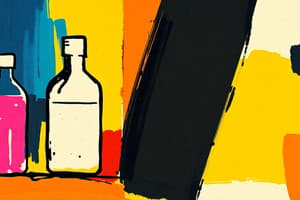Podcast
Questions and Answers
What is one dimension of product quality that marketers must choose when developing a product?
What is one dimension of product quality that marketers must choose when developing a product?
- Design consistency
- Brand identity
- Quality level (correct)
- Packaging materials
Which of the following best describes the concept of design in product attributes?
Which of the following best describes the concept of design in product attributes?
- Design is synonymous with styling and branding.
- Design is purely a marketing strategy without impact on performance.
- Design contributes to both usefulness and aesthetic appeal. (correct)
- Design only refers to the physical appearance of the product.
What is one primary function of labeling on packaging?
What is one primary function of labeling on packaging?
- To identify and describe the product. (correct)
- To provide pricing information.
- To increase production efficiency.
- To promote the product through social media.
What is one benefit of branding for consumers?
What is one benefit of branding for consumers?
Which of the following is NOT a part of packaging?
Which of the following is NOT a part of packaging?
What does the core product primarily address?
What does the core product primarily address?
Which characteristic is NOT part of the actual product?
Which characteristic is NOT part of the actual product?
What are consumer products primarily defined by?
What are consumer products primarily defined by?
Which of the following is true about convenience products?
Which of the following is true about convenience products?
Specialty products are characterized by what?
Specialty products are characterized by what?
Unsought products can be defined as products that consumers:
Unsought products can be defined as products that consumers:
Which product attribute involves defining the benefits offered to consumers?
Which product attribute involves defining the benefits offered to consumers?
In what way do augmented products enhance the consumer experience?
In what way do augmented products enhance the consumer experience?
Flashcards
Product Definition
Product Definition
Anything offered to a market for acquisition, use, or consumption that might satisfy a want or need.
Core Product
Core Product
The most fundamental part of a product, representing the problem-solving benefits it offers.
Actual Product
Actual Product
The tangible aspects of a product, including its quality, features, design, brand, and packaging.
Augmented Product
Augmented Product
Signup and view all the flashcards
Consumer Products
Consumer Products
Signup and view all the flashcards
Convenience Products
Convenience Products
Signup and view all the flashcards
Shopping Products
Shopping Products
Signup and view all the flashcards
Specialty Products
Specialty Products
Signup and view all the flashcards
Product Quality
Product Quality
Signup and view all the flashcards
Product Design vs. Style
Product Design vs. Style
Signup and view all the flashcards
What is a brand?
What is a brand?
Signup and view all the flashcards
What is Packaging?
What is Packaging?
Signup and view all the flashcards
What are Labels?
What are Labels?
Signup and view all the flashcards
Study Notes
Product Strategy
- A product is anything offered to a market for acquisition, use, or consumption to satisfy a want or need.
- Products include: physical objects, services, people, places, organizations, and ideas.
Levels of a Product
- Core Product: The most basic level, focusing on the problem-solving benefits the buyer receives.
- Actual Product: Includes quality level, features, design, brand name, packaging.
- Augmented Product: Additional consumer services and benefits beyond the core and actual product. Warranties, customer care, and financing are examples.
Product Classification
- Products and services are categorized into two broad classes based on the end user: consumer products and industrial products.
- Consumer Products: Purchased by individuals for personal use.
- Convenience Goods: Frequently bought, immediately, with minimal effort (e.g., toothpaste, candy).
- Shopping Goods: Less frequently purchased, requiring careful comparison of suitability, quality, price and style (e.g., furniture, clothes).
- Specialty Goods: Unique characteristics – consumers will go out of their way to purchase (e.g., luxury cars, designer clothes).
- Unsought Goods: Consumers don't know about or do not initially want them (e.g, insurance, burial plans).
Marketing Considerations for Consumer Products
- This section details marketing strategies dependent upon product type (convenience, shopping, specialty, unsought). This includes considerations on product, price, place, and promotion.
Individual Product Decisions
- Product Attributes
- Branding
- Packaging
- Labeling
Product Attributes
- Product Attributes are the characteristics that define a product or service that delivers a benefit. Examples of measurable product benefits include quality, features, and design.
- Product Quality: Two-dimensions to consider for level of quality. One is the target level the product needs to support market position, the second is the quality consistency in performance.
- Design: It's a bigger concept than just style. Style describes appearance; design encompasses usefulness and functionality alongside aesthetics.
- Branding: A name, symbol, term, sign, or combination uniquely identifying a seller's product or service.
- Packaging: The container or wrapper for a product. Includes brand name, instructions, ingredients, and other product details.
- Labeling: Physical tags or graphics on the package that perform various functions, like identifying a brand, explaining products, describing features, and promoting products.
Studying That Suits You
Use AI to generate personalized quizzes and flashcards to suit your learning preferences.




